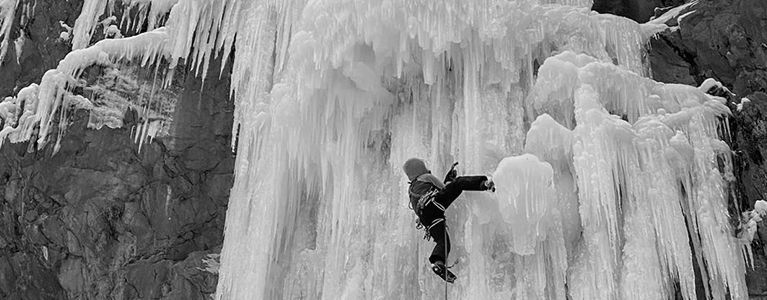

Ice Climbing and over-attendance
Knowing how to enjoy it safely
Ice climbing is an ephemeral discipline that consists of climbing frozen waterfalls. Formerly reserved for a few initiates who trained to climb larger routes in the high mountains, this discipline has become a full-fledged activity today in its own right. Each season, more and more practitioners take to the ice armed with the latest and greatest ice axes and crampons.
Smartphones are also part of the panoply of ice climbers and social networks have become an important vector promoting climbs, making it possible to transmit the conditions but also arouse envy in a large number of people. Global warming is also shortening the seasons. Cascades are formed for less time and less often. It has therefore become common to see several roped parties engage in the latest “fashionable” waterfall on Facebook or quite simply the only waterfall formed in the valley...
Even if it is rather nice to see the family of mountaineers grow, the other side of the coin is inevitable over attendance. To date, it seems utopian to imagine a single rope per icefall. This situation inevitably generates a potential increase in accidents.
So let's remember some key points to increase our safety margins and preserve this fantastic activity. If some of these tips seem trivial, all their counter-examples could be seen on the pitch just at the start of the season.
First of all, let's keep in mind that ice climbing is not sport climbing but rather “concentrated” mountaineering: this activity requires an essential analysis of the environment, the conditions and our own capacities for the sake of autonomy and individual security management.

Before going for it, while preparing your day
Why this icefall?
Is it my own choice or am I seduced or even "pushed" by the fact that everyone has done this one?
Prepare your outing by carefully leaning over the topo’s, on the detailed map.
Are there other alternatives in the sector?
What is the info?
What is the nature of the information disseminated on the networks? Who are the climbers? What is their experience?
Look for the facts and not the feelings of the "it was great" type, consult various opinions, from local climbers or professionals: state of the structure, temperatures, quality of the ice, observations of particular phenomena (ice falls, flows water, cracks, etc.).
What are the conditions on chosen day?
Take the weather report and the avalanche info carefully: is the icefall exposed to avalanches? Is this avalanche risk acceptable? Look at the temperature evolution of the last 10 days to identify if you are in one of the 3 risk scenarios:
- A pronounced rise in temperatures
- A sudden fall in temperatures
- Significant variations between day and night or from day to day.
Also find out about the structure of the icefall itself: is it freestanding or does it have elements liable to collapse (columns, stalactites)?
Finally is the roped party at the level of this icefall? (State of fitness, motivation of partners, definition of leadership).
When arriving on the spot:
Observe the icefall and identify the objective dangers (Avalanches, falling ice, presence other roped parties ...).
If I was alone, would I go climbing?
Are there any ledges that can stop any ice fall?
Observe and find the route you can take, using areas favorable to progression and imagining protected relay locations.
At the foot of the waterfall:
Choose a location protected from objective dangers to equip yourself.
Put on your helmet first!
During the ascent:
Protected relay:
Make sure you place your belays protected from objective dangers (avalanche, ice fall, rock fall, leader's fall ...) Know how to use naturally protected areas: ice caves, overhangs under jellyfish like ice features, or under an overhung rock, etc.
Do not hesitate to do a short pitch or on the contrary longer pitch (or even to progress in a taut rope) to find an ideal location.
A protected belay will allow you to expose only one member of the rope.
NB: It is sometimes surprising to see two roped parties making their belay’s side by side, in the center of a waterfall, in the axis of a gully that channels everything that can fall from the top, while this waterfall is exposed to the avalanches, that another roped party climbs above and that 2 belays on bolts, protected by an overhang are close and very easily accessible....
Unbreakable relay:
You should have no doubts about the strength of your belays! They must consist of 2 or even 3 ice screws. A “V”-thread is also always possible and greatly increases the reliability of the assembly.
Lowering :
The ascent is one thing, the descent, especially under possible threats (stalactites, slopes), should not be underestimated. Sometimes you have to know how to wait at the top as at the foot of an icefall so as not to expose yourself. Hot beverage, warm and dry clothes are part, just like a few eyelets, cords, medicine chest and compression bandage, of the musts of your bag!
Attention to the little "lazy":
Watch out for that little inner voice that tells you at the belay: "yeah, no need to add a screw ..." when the ice is not really good quality or to the one that tells you during your descent: " oh, perfect, a “V” thread is already made, I'll save time ... "while this one is just under a threatening ice sword. Practice making a “V” thread: it will be done when your climbing partner arrives.
Finally, don't forget that it is sometimes better to change plans or give up than go back by chopper (for the lucky ones ...)
To go further in your knowledge and your analysis of ice, you can consult the book: "Ice arts experiences and techniques".
To learn from the collective experience: icefall-data.org
Have a good climb everyone, be careful and have fun!
Nicolas Beauquis, ice climbing enthusiast for more than 20 years, mountain rescuer at PGHM and mountain guide.
Jérôme Blanc Gras, passionate about ice climbing for 30 years, co-author with Manu Ibarra of the book “Ice arts experiences and techniques” and high mountain guide.



